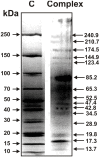Very Stable Two Mega Dalton High-Molecular-Mass Multiprotein Complex from Sea Cucumber Eupentacta fraudatrix
- PMID: 34577173
- PMCID: PMC8470729
- DOI: 10.3390/molecules26185703
Very Stable Two Mega Dalton High-Molecular-Mass Multiprotein Complex from Sea Cucumber Eupentacta fraudatrix
Abstract
In contrast to many human organs, only the human liver can self-regenerate, to some degree. Some marine echinoderms are convenient objects for studying the processes of regenerations of organs and tissues. For example, sea cucumbers Eupentacta fraudatrix can completely restore within several weeks, the internal organs and the whole body after their division into two or three parts. Therefore, these cucumbers are a very convenient model for studying the general mechanisms of regeneration. However, there is no literature data yet on which biomolecules of these cucumbers can stimulate the regeneration of organs and the whole-body processes. Studying the mechanisms of restoration is very important for modern biology and medicine, since it can help researchers to understand which proteins, enzymes, hormones, or possible complexes can play an essential role in regeneration. This work is the first to analyze the possible content of very stable protein complexes in sea cucumbers Eupentacta fraudatrix. It has been shown that their organisms contain a very stable multiprotein complex of about 2000 kDa. This complex contains 15 proteins with molecular masses (MMs) >10 kDa and 21 small proteins and peptides with MMs 2.0-8.6 kDa. It is effectively destroyed only in the presence of 3.0 M MgCl2 and, to a lesser extent, 3.0 M NaCl, while the best dissociation occurs in the presence of 8.0 M urea + 0.1 M EDTA. Our data indicate that forming a very stable proteins complex occurs due to the combination of bridges formed by metal ions, electrostatic contacts, and hydrogen bonds.
Keywords: model of tissues and body regeneration; sea cucumber Eupentacta fraudatrix; very stable 2000 kDa protein complex.
Conflict of interest statement
The authors declare the absence of conflict of interest.
Figures




Similar articles
-
Comparison of the Content of Several Elements in Seawater, Sea Cucumber Eupentacta fraudatrix and Its High-Molecular-Mass Multiprotein Complex.Molecules. 2022 Mar 17;27(6):1958. doi: 10.3390/molecules27061958. Molecules. 2022. PMID: 35335321 Free PMC article.
-
Protease and DNase Activities of a Very Stable High-Molecular-Mass Multiprotein Complex from Sea Cucumber Eupentacta fraudatrix.Int J Mol Sci. 2022 Jun 15;23(12):6677. doi: 10.3390/ijms23126677. Int J Mol Sci. 2022. PMID: 35743119 Free PMC article.
-
Two fucosylated chondroitin sulfates from the sea cucumber Eupentacta fraudatrix.Carbohydr Polym. 2017 May 15;164:8-12. doi: 10.1016/j.carbpol.2017.01.034. Epub 2017 Jan 11. Carbohydr Polym. 2017. PMID: 28325347
-
Saponins from Sea Cucumber and Their Biological Activities.J Agric Food Chem. 2018 Jul 18;66(28):7222-7237. doi: 10.1021/acs.jafc.8b01770. Epub 2018 Jul 6. J Agric Food Chem. 2018. PMID: 29932674 Review.
-
Mechanisms of cancer cell killing by sea cucumber-derived compounds.Invest New Drugs. 2017 Dec;35(6):820-826. doi: 10.1007/s10637-017-0505-5. Epub 2017 Sep 18. Invest New Drugs. 2017. PMID: 28920157 Free PMC article. Review.
Cited by
-
Comparison of the Content of Several Elements in Seawater, Sea Cucumber Eupentacta fraudatrix and Its High-Molecular-Mass Multiprotein Complex.Molecules. 2022 Mar 17;27(6):1958. doi: 10.3390/molecules27061958. Molecules. 2022. PMID: 35335321 Free PMC article.
-
Protease and DNase Activities of a Very Stable High-Molecular-Mass Multiprotein Complex from Sea Cucumber Eupentacta fraudatrix.Int J Mol Sci. 2022 Jun 15;23(12):6677. doi: 10.3390/ijms23126677. Int J Mol Sci. 2022. PMID: 35743119 Free PMC article.
References
-
- Hyman L.H. The Coelome Bilateria. McGraw-Hill Book Co.; New York, NY, USA: 1955. The invertebrates: Echinodermata; p. 763.
-
- Dolmatov I.Y., Mashanov V.S. Regeneration in Holothurians. Dalnauka; Vladivostok, Russia: 2007. pp. 1–212.
-
- Dolmatov I.Y. Regeneration of the digestive system in holothurians. Zhurnal Obshch. Biol. 2009;70:319–330. - PubMed
-
- Dolmatov I.Y. Regeneration of the aquapharyngeal complex in the holothurian Eupentacta fraudatrix (Holothuroidea, Dendrochirota) In: Taban C.H., Boilly B., editors. Keys for Regeneration. Volume 23. Karger; Basel, Germany: 1992. pp. 40–50. - PubMed
-
- Levin V.S. Dalnevostochnyi Trepang. Biologiya, Dobycha, Vosproizvodstvo (The Far East. Trepang. Biology, Catching, Reproduction) STMicroelectronics; Petersburg, Russia: 2000. pp. 1–201.
MeSH terms
Substances
Grants and funding
LinkOut - more resources
Full Text Sources
Miscellaneous

